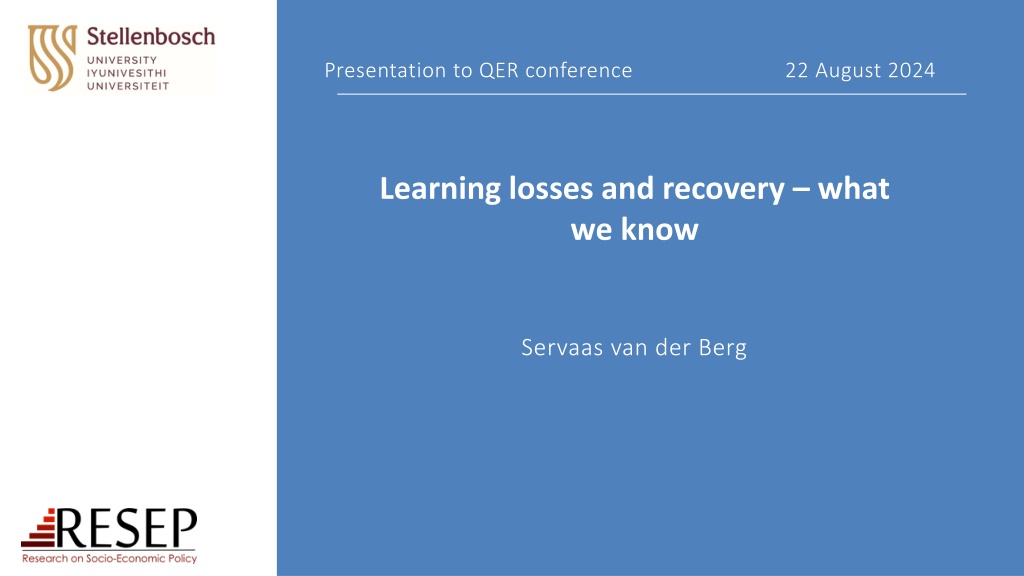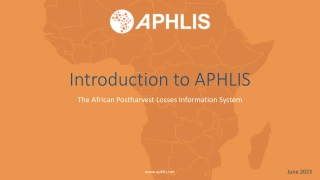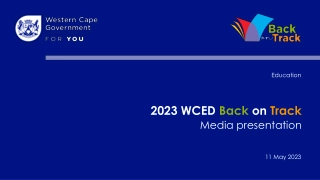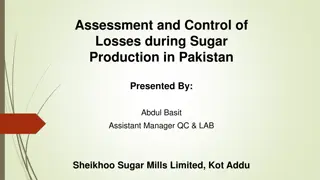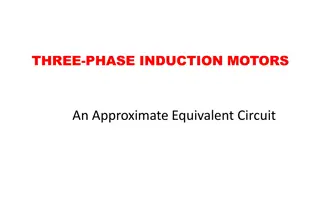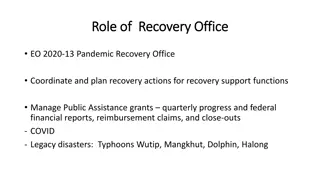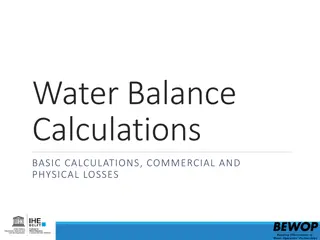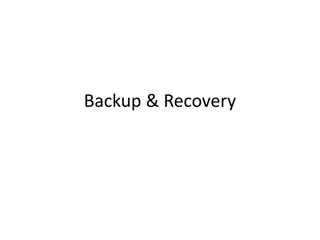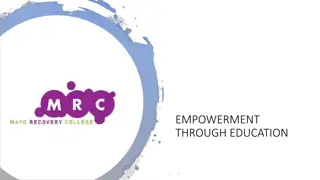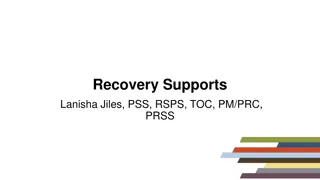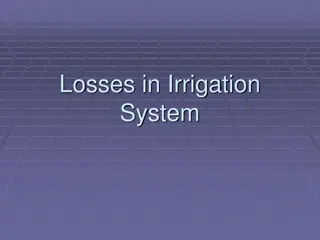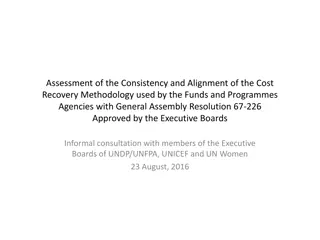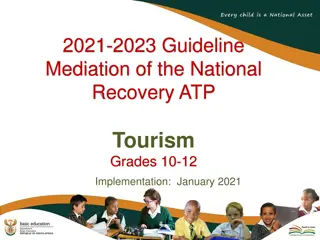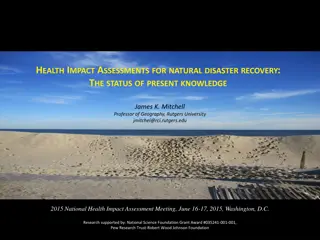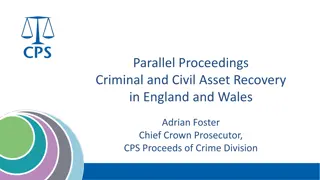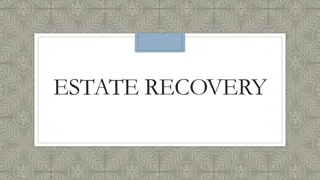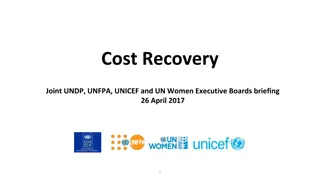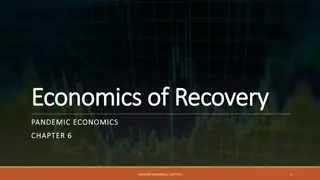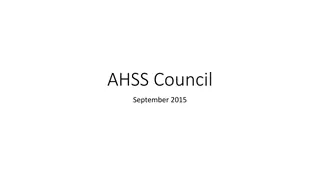Learning Losses and Recovery: What We Know
The presentation at the QER conference on August 22, 2024, explores learning losses and recovery efforts post-pandemic, highlighting global impacts, implications in South Africa, and strategies for educational reform. It discusses the challenges faced, methodologies used, and implications of the study findings for the education sector. Various studies and reports are referenced to support the insights shared.
Download Presentation

Please find below an Image/Link to download the presentation.
The content on the website is provided AS IS for your information and personal use only. It may not be sold, licensed, or shared on other websites without obtaining consent from the author.If you encounter any issues during the download, it is possible that the publisher has removed the file from their server.
You are allowed to download the files provided on this website for personal or commercial use, subject to the condition that they are used lawfully. All files are the property of their respective owners.
The content on the website is provided AS IS for your information and personal use only. It may not be sold, licensed, or shared on other websites without obtaining consent from the author.
E N D
Presentation Transcript
Presentation to QER conference 22 August 2024 Learning losses and recovery what we know Servaas van der Berg
References Ardington, C. 2023. Funda Wande Limpopo Evaluation: Second Midline Report. Cape Town: SALDRU. Ardington, C., Wills, G., & Kotze, J. 2021. COVID-19 learning losses: Early grade reading in South Africa. International Journal of Educational Development Azevedo, JPW, Rogers, F.H. et al 2020. The state of the global education crisis : A path to recovery. World Bank: Washington D.C.. B hmer, Bianca & Wills, Gabrielle. 2023. COVID-19 and inequality in reading outcomes in South Africa: PIRLS 2016 and 2021. Resep: Stellenbosch Fleisch, B., Schoer, V., Olivier, J., Poswell, L. & Zulu, Z. 2024. Zazi iZandi: Leveraging the public employment stimulus to lay literacy foundations in Grades R and 1. Reading Panel 2030 Advisory Note 4. Gustafsson, Martin. 2024. A brief look behind the flat 2015 to 2019 TIMSS Grade 5 trend for South Africa. Resep: Stellenbosch Gustafsson, Martin. 2023.Education is improving but the message is hard to convey. Econ 3x3. Van der Berg, S., Hoadley, U., Galant, J., van Wyk, C. & B hmer, B. 2022. Learning losses from COVID-19 in the Western Cape. Evidence from Systemic Tests. Resep: Stellenbosch. Van der Berg, Servaas & B hmer, Bianca. 2024 (in print). South Africa: COVID-19 learning losses and attempts at recovery in an underperforming and unequal education system. Ch .11 in: Nuno Crato & Harry A. Patrinos. Improving national education systems after Covid-19. Springer. Whitelaw, Emma & Branson, Nicola. 2024. Assessment matters: What can we understand about National Senior Certificate results during COVID-19 from university entrance exams? Covid-Generation Research Note. Resep: Stellenbosch Wills, Gabrielle. 2023. Early grade repetition in South Africa: Implications for reading. Resep: Stellenbosch Wills, Gabrielle & Qvist, Jess. 2023. Repetition and dropout in South Africa before, during and after COVID-19. Covid-generation research project. Resep: Stellenbosch. Wills, Gabrielle & Van der Berg, Servaas. 2022. Covid-19 Disruptions and Education in South Africa: Two Years of Evidence. Resep: Stellenbosch
The pandemic caused an upheaval in education Rising poverty, mental and social stress Lost learning time Learning losses Leniency in tests to soften the effect Massive acceleration in flows though higher grades Results: Compositional effects in matric more weaker learners reach matric Learning losses even the stronger candidates are greatly affected Nevertheless, between 2019 and 2021, NSC passes increase by 31%
Learning losses occurred even in rich countries France: Baccalaureate exam (required for university admission) pass rate dropped from 95.7% in 2020 to 88.3% in 2021 Japan: Average maths score for university entrance exam declined by 5.4 points from 2020 to 2021 Australia, Belgium, Canada, France, Germany, Italy, Japan, and the United States: McKinsey study found students were on average 4 months behind in reading and five months behind in maths by June 2021 compared to pre- pandemic levels
Was there grade inflation in matric? We show that applicants admission point scores, derived from NSC grades, have risen relative to NBT scores, which remained similar over time since the onset of COVID-19. Gains were more prominent among relatively more disadvantaged applicants and those at the bottom of the performance distribution. This could indicate grade inflation in the NSC associated with the pandemic, or other factors such as shifting subject combinations. Focusing on Mathematics, the comparison of NBT and 2021 NSC Mathematics scores corroborates a grade inflation theory, but NSC results reverted close to pre-pandemic levels in 2022. (Whitelaw & Branson 2024: Abstract)
Did dropout increase during the pandemic? Administrative data does not support rising dropout at the secondary school level during the pandemic Household survey data points to declines in the percentage of youth aged 15-19 not in school and without a completed secondary education during the pandemic although these estimates had reverted closer to pre-pandemic levels by the start of 2023. (Wills & Qvist, 2023: 1)
Reduced repetition in lower grades may reduce class sizes but needs to be underpinned by remediation Lower repetition rates in early grades may help to reduce early grade class sizes (and direct costs on the system) but containing Grade 1 repetition could also have implications for learning in the foundational years in the absence of alternate remedial programmes Evidence shows that learners that are held back in the foundational years are academically weaker and have not mastered basic reading skills that are only taught in the Foundation Phase (Wills & Qvist, 2023: 30)
Magnitude of learning losses in Western Cape Learning losses: 1 to 1 years in Maths to 1 year in Reading Smaller losses in Quintile 5 schools, but more than half of the above Large losses in Reading for isiXhosa schools in Grade 6, suggesting that Covid has worsened the difficulty of the language transition How far can one extrapolate from this? What are the policy options How to create time How much catch-up can there be?
Learning losses by grade and subject WCED Systemic Tests, 2019 vs 2021
SA performance in international tests SA performance in international tests 400 560 380 550 360 540 Scores (Excuding SACMEQ) SACMEQ scores 340 530 320 520 300 510 280 500 260 490 240 480 2000 2005 2010 2015 2020 Gr5 TIMSS Maths Gr4 PIRLS Reading Gr6 SACMEQ Reading Gr9 TIMSS Maths Gr4 PIRLS Reading - alternative path Gr9 TIMSS Science Gr6 SACMEQ Maths
PIRLS reading comprehension scores by language of testing, 2016 & 2021 Socio-economic and language gaps widened Source: B hmer (forthcoming) using PIRLS 2016 and 2021. The scores are learner weighted and calculated using 5 plausible values. Standard errors are calculated using a jackknife-based resampling scheme.
PIRLS Gr4 reading comprehension by gender, 2016 vs 2021 and the pro-girl gap also widened 400 350 347 320 317 300 295 288 250 260 PIRLS score 200 150 100 50 0 Girls Boys 2021 All 2016
PIRLS reading achievement benchmarks and thresholds reached in 2016 and 2021(Source: Van der Berg & B hmer 2024) 1.9% 3.0% High & Advanced ( 550) Intermediate (475 - 550) 5.6% 5.6% Heterogeneity in reading Low (400 - 475) 10.8% 14.5% ability within a school already spanned 3 Very low, below Low (200 - 400) 54.1% grades in 2016; 64.6% this rose to 3.8 years in 2021. Below very low (<200) 26.5% 13.4% 2016 2021
Other evidence of learning losses DBE s Early Grade Reading Study and a Funda Wande evaluation in a sample of non-fee-paying schools in the Eastern Cape, KwaZulu-Natal and Mpumalanga After one year of the pandemic, grade 2s and 4s learned 57-70% of a year less in home language reading and 62%-81% in English reading relative to the 2019 cohort (Ardington et al., 2021) After two years of these disruptions, the home language reading development of grade 4s in a group of no-fee schools in the Northwest was 54% 118% of a year of learning behind the 2018 grade 4 cohorts (Wills & Van der Berg, 2024) How much do SA learners learn in a year? Azevedo et al. (2020) assume: 0.20 SD for Low Income Countries 0.30 SD for Lower-Middle-Income Countries 0.40 SD for Upper-Middle-income Countries 0.50 SD for High-Income Countries
Learning losses and recovery in reading by grade WCED Systemic Tests, 2019-2023 (Source: MEC Media Statement, 7 Feb 2024) 100 95 90 85 80 75 2019 100 100 100 2021 82 92 93 2022 86 84 94 2023 95 88 96 Gr3 Lang Gr6Lang Gr9 Lang Gr3 Lang Gr6Lang Gr9 Lang
Learning losses and recovery in mathematics by grade WCED Systemic Tests, 2019-2023 (Source: MEC Media Statement, 7 Feb 2024) 100 95 90 85 80 75 2019 100 100 100 2021 76 84 95 2022 81 86 83 2023 89 91 90 Gr3Maths Gr6Maths Gr9Maths Gr3Maths Gr6Maths Gr9Maths
Other evidence of recovery A Funda Wande RCT in Limpopo in grades 1-3 found strong gains after 1 years: With workbooks and teacher training, 0.22 SD gain in home language reading, 0.26 SD in maths Those who also had teachers assistants gained 0.51 SD in reading and 0.50 SD in maths (Ardington 2023) Zazi iZandi: Youth employed in 25 schools on the Presidential Youth Employment Initiative s Basic Education Employment Intervention were trained to teach letter recognition using a structured, play-based approach. The rate of improvement in letter recognition in the 6-8 weeks was much higher than during the previous months, so the programme will enter the next testing phase (Fleish et al., 2024).
